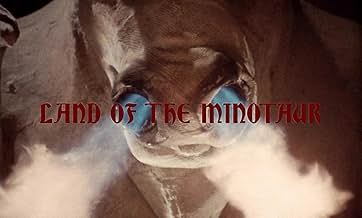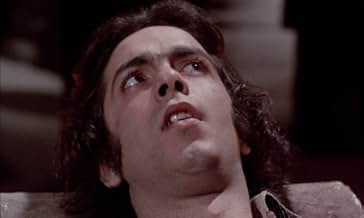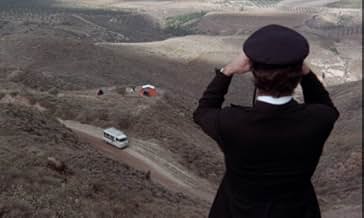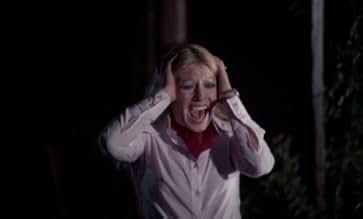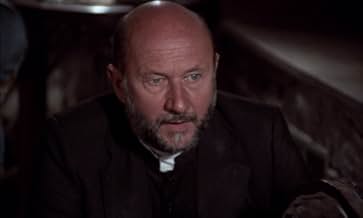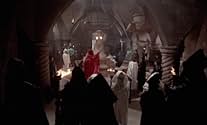IMDb-BEWERTUNG
4,3/10
1976
IHRE BEWERTUNG
Füge eine Handlung in deiner Sprache hinzuTourists are kidnapped by a devil-worshipping cult, and a priest tries desperately to save them. A gruesome tale of the devil and human sacrifice.Tourists are kidnapped by a devil-worshipping cult, and a priest tries desperately to save them. A gruesome tale of the devil and human sacrifice.Tourists are kidnapped by a devil-worshipping cult, and a priest tries desperately to save them. A gruesome tale of the devil and human sacrifice.
Kostas Karagiorgis
- Milo
- (as Costa Skouras)
Dimitris Bislanis
- Sgt. Vendris
- (as Fernando Bislani)
Anna Matzourani
- Widow - Mrs. Mikaelis
- (as Anna Mantzourani)
Nikos Verlekis
- Ian
- (as Nikos Verlel Verlekis)
Vanna Reville
- Beth
- (as Gelsomina)
George Veulis
- Chauffeur - Max
- (as George Vevlis)
Meira Shore
- Maid
- (as Meira)
Jessica Dublin
- Mrs. Zagros
- (as Jessica)
Robert Rietty
- Sgt. Vendris
- (Synchronisation)
Empfohlene Bewertungen
The presence of Donald Pleasance and Peter Cushing two players well schooled in the horror film make Land Of The Minotaur an endurable feast. Speaking of feasting these two guys digested well a complete diet of ham to get through this film.
Pleasance plays a priest and Cushing a local nobleman by day, but by night he's the leader of a cult of devil worshipers. The object of their veneration is the ancient Greek monster the Minotaur who according to this film is really just another name for the Christian Satan.
The cult has captured some visiting young tourists and are using them of course for their own nefarious purposes. So if you can't figure out where this is going you haven't been exposed to too much the work of the two British players.
Location photography in Greece helps also, but mostly watch it for these two thespian legends.
Pleasance plays a priest and Cushing a local nobleman by day, but by night he's the leader of a cult of devil worshipers. The object of their veneration is the ancient Greek monster the Minotaur who according to this film is really just another name for the Christian Satan.
The cult has captured some visiting young tourists and are using them of course for their own nefarious purposes. So if you can't figure out where this is going you haven't been exposed to too much the work of the two British players.
Location photography in Greece helps also, but mostly watch it for these two thespian legends.
After an English and French couple- followed by 2 Americans and an Australian girl- go missing, while searching for the ritual grounds of an ancient Minoan cult, a private detective from New York is hired, by a local priest, to investigate their disappearances.
It turns out that this Greek village is home to a long forgotten priesthood, that worships the idol of a Minotaur possessed by Satan, himself.
Their priest is a local baron, who has been exiled from his homeland.
And they are grooming a young girl to be the priestess, responsible for making sacrifices to their demon god.
The closer the two men get to answers...the more people die.
And they just barely escape with their own lives.
Now, the only way to stop this demonic cult, is by eliciting some divine intervention.
For, if they are to save the last couple, before they too are sacrificed, then they must descend directly into the belly of the beast to do so- the Minotaur's lair...from which no one leaves alive.
And only God can save them...if it's not already too late...
While not the best satanic cult oriented folk horror ever made...it has some positive elements.
For instance, the Minotaur's lair is pretty damn cool.
But the ending was all a bit rushed, and rather implausible.
Which detracts from the overall enjoyability a little, however, it's entertaining enough to be worth a watch.
5.5 out of 10.
It turns out that this Greek village is home to a long forgotten priesthood, that worships the idol of a Minotaur possessed by Satan, himself.
Their priest is a local baron, who has been exiled from his homeland.
And they are grooming a young girl to be the priestess, responsible for making sacrifices to their demon god.
The closer the two men get to answers...the more people die.
And they just barely escape with their own lives.
Now, the only way to stop this demonic cult, is by eliciting some divine intervention.
For, if they are to save the last couple, before they too are sacrificed, then they must descend directly into the belly of the beast to do so- the Minotaur's lair...from which no one leaves alive.
And only God can save them...if it's not already too late...
While not the best satanic cult oriented folk horror ever made...it has some positive elements.
For instance, the Minotaur's lair is pretty damn cool.
But the ending was all a bit rushed, and rather implausible.
Which detracts from the overall enjoyability a little, however, it's entertaining enough to be worth a watch.
5.5 out of 10.
"The Devil's Men" (aka "Land of the Minotaur") is by no means a masterpiece, but very few horror films are. While there are good ones and bad ones, ultimately they're nothing more than *fantasies*--they ask you to suspend your disbelief. Horror films are not (or should not be) judged according to the same criteria as "Citizen Kane". Think "The Devil's Men" is bad horror? See "Ghost Story" and learn how the genre can be reduced to a pathetic cartoon (despite a big budget and a good cast). Think this is a low point in Peter Cushing's career? See "The Blood Beast Terror". This film actually has a lot going for it: strong performances from Cushing and Donald Pleasence (Cushing is particularly great in one of his few downright villainous roles), an eerie synthetic score by Brian Eno, and fine cinematography. It does get a bit dull in spots, but I haven't seen many movies that didn't. Director Kostas Karagiannis knew how to establish the proper mood for a film of this kind: witness the scene in which Pleasence, as the village priest, walks from his living quarters to the church to pray. He's a small figure in the immensely old, pagan landscape of Greece, which seems ready to swallow him up (and Eno's cue for the scene underscores this threatening feeling). Young horror auteurs, take note: it's little things like this that give the viewer a sense of unease. If, on the other hand, you just want to make the viewer feel sick or laugh, you'll bombard him with severed limbs and intestines. "The Devil's Men" is no award winner, but it's a creepy little film that's fun to watch. Its reputation as a bomb is undeserved.
The Devil's Men represents what turned out to be one of the last gasps of the occult obsessed horror scene of the 70's shortly before Halloween came along, tore up the rule book, set fire to it and kicked it screaming through a plate glass window.
To cut a long story short a couple of enterprising Greek film makers fancy their chances of nailing together a new film franchise featuring the unlikely double act of womanising, wise talking American investigator Milo and stuffy but kind hearted priest Father Roche. An exiled nobleman is mixed up in some satanic jiggery pokery - offering up tourists as sacrifices to an extremely unfrightening effigy of the minotaur and only Milo and Roche can stop him!
Or something like that.
The reality is however horribly dull, frustrating and loaded with wasted opportunities. I strongly suspect that the fledgling film makers blew most of the budget on getting Donald Plesance, Peter Cushing and Brian Eno (for the soundtrack) onboard and hoped that would be enough to sway audiences in the English speaking world.
It isn't. The Devil's Men looks beautiful with assured, camera-work and fantastic locations. Eno's score, though basically just a one chord drone that he probably cranked out in an afternoon is suitably atmospheric and the movie is laden with cracking 70's crumpet including that Austrailian sort from Fawlty Towers and uber hottie Jane Lyle of Island of Death infamy. But there the positives end. Cushing sleepwalks through it, looking like he has a corn cob up his bum and Pleasance fusses about trying his best, but never quite getting things right. To make matters worse the character of Milo is appallingly flimsy and unlikeable.
Okay, so it doesn't look that good. But from there the film simply refuses to go anywhere. There is an insinuation that the local villagers are possessed, but to be fair to them, they never really do anything very much other than shuffle about looking glassy eyed. Perhaps they were just tired? Just when you are sure things will come to some kind of a head Milo and Roche interrupt the Baron's satanic party with laughable ease, sending him on to meet his maker. The statue of the minotaur falls silent and hey presto! Satan is defeated.
Yeah right.
The inane optimism that The Devil's Men might be the first of a series of films is hammered home by Father Roche's final line mere seconds before the ridiculously rushed ending.
"Who knows Milo? Perhaps one day I may call upon you again to help defeat the Antichrist."
I'm sure you'll be putting that call in any day now Donald.
To cut a long story short a couple of enterprising Greek film makers fancy their chances of nailing together a new film franchise featuring the unlikely double act of womanising, wise talking American investigator Milo and stuffy but kind hearted priest Father Roche. An exiled nobleman is mixed up in some satanic jiggery pokery - offering up tourists as sacrifices to an extremely unfrightening effigy of the minotaur and only Milo and Roche can stop him!
Or something like that.
The reality is however horribly dull, frustrating and loaded with wasted opportunities. I strongly suspect that the fledgling film makers blew most of the budget on getting Donald Plesance, Peter Cushing and Brian Eno (for the soundtrack) onboard and hoped that would be enough to sway audiences in the English speaking world.
It isn't. The Devil's Men looks beautiful with assured, camera-work and fantastic locations. Eno's score, though basically just a one chord drone that he probably cranked out in an afternoon is suitably atmospheric and the movie is laden with cracking 70's crumpet including that Austrailian sort from Fawlty Towers and uber hottie Jane Lyle of Island of Death infamy. But there the positives end. Cushing sleepwalks through it, looking like he has a corn cob up his bum and Pleasance fusses about trying his best, but never quite getting things right. To make matters worse the character of Milo is appallingly flimsy and unlikeable.
Okay, so it doesn't look that good. But from there the film simply refuses to go anywhere. There is an insinuation that the local villagers are possessed, but to be fair to them, they never really do anything very much other than shuffle about looking glassy eyed. Perhaps they were just tired? Just when you are sure things will come to some kind of a head Milo and Roche interrupt the Baron's satanic party with laughable ease, sending him on to meet his maker. The statue of the minotaur falls silent and hey presto! Satan is defeated.
Yeah right.
The inane optimism that The Devil's Men might be the first of a series of films is hammered home by Father Roche's final line mere seconds before the ridiculously rushed ending.
"Who knows Milo? Perhaps one day I may call upon you again to help defeat the Antichrist."
I'm sure you'll be putting that call in any day now Donald.
My, my, my: Peter Cushing and Donald Pleasance must have been desperate for work to have lent their talents to this turkey. A horribly muddled story about satanism in modern day Greece, Land Of The Minotaur (aka The Devil's Men) is a misfire on more-or-less every level imaginable. It has precious few scares (always a slight flaw for a "horror" movie, don't you think?); weak performances; countless scenes where characters foolishly wander off alone or turn down the opportunity to remain in the safety of a group; and some rather irritating editing techniques which add nothing whatsoever to the proceedings. I got prematurely excited at the prospect of Cushing and Pleasance working together 17 years after The Flesh And The Fiends - but this film isn't worth getting remotely excited about; it's a huge let-down and rather an embarrassment for its much worthier leads.
In a remote region of Greece, outsiders such as tourists and archaeologists keep going missing, and local priest Father Roche (Donald Pleasance) suspects that something sinister is afoot. He writes to his friend, New York private eye Milo Kaye (Costas Skouras), asking him to fly out to Greece to help him get to the bottom of the mystery. In the meantime, three more visitors - Beth (Vanna Reville), Ian (Nikos Verlekis) and Tom (Robert Behling), who are all personal friends of Father Roche - go missing while snooping around nearby Greek ruins. Milo eventually arrives in Greece, but is initially dubious about Father Roche's beliefs that the missing people have been snatched for satanic sacrifices. Milo and Father Roche are also joined by Laurie (Luan Peters), the girlfriend of missing man Tom. Together, they uncover the activities of a Minoan devil-worshipping cult headed by creepy Carpathian exile Baron Corofax (Peter Cushing). These crazed cultists have been busily sacrificing their victims to a statue of the minotaur. Furthermore, they seemingly cannot be killed by normal means, so Father Roche has to use a variety of religious artifacts in his fight against them.
Land Of The Minotaur should have been much better than it actually is. The plot is so wacky and improbable that it has all the hallmarks of an enjoyably goofy cult/camp favourite. But the handling is just awful. Director Costas Carayiannis has no idea how to link the narrative together cohesively, so the whole thing progresses like it was being made up on a day-to-day basis. He also has no idea how to coax convincing performances from his cast, so they are left to embarrass themselves in either dreadfully hammy (Pleasance, Cushing) or dreadfully amateurish (Skouras, Peters) performances. What's worse is that the narrative makes no sense. Why would Father Roche seek help from a private eye who is utterly flippant about his beliefs? How does Roche know that the sacrifices only occur during a full moon? How can the minotaur statue speak? Why is one one of the sacrificial victims instructed during a vision to stab Father Roche, only to herself be stabbed a few scenes later before getting a chance to carry it out? And - most baffling of all - why does Father Roche drag Milo halfway around the world to help him when all he needs is a crucifix and and some holy water to dispose of the bad guys? These questions - and more - will pop into your mind during Land Of The Minotaur.... but, alas, there are no answers to be had. Frustrating, dumb and disappointing!
In a remote region of Greece, outsiders such as tourists and archaeologists keep going missing, and local priest Father Roche (Donald Pleasance) suspects that something sinister is afoot. He writes to his friend, New York private eye Milo Kaye (Costas Skouras), asking him to fly out to Greece to help him get to the bottom of the mystery. In the meantime, three more visitors - Beth (Vanna Reville), Ian (Nikos Verlekis) and Tom (Robert Behling), who are all personal friends of Father Roche - go missing while snooping around nearby Greek ruins. Milo eventually arrives in Greece, but is initially dubious about Father Roche's beliefs that the missing people have been snatched for satanic sacrifices. Milo and Father Roche are also joined by Laurie (Luan Peters), the girlfriend of missing man Tom. Together, they uncover the activities of a Minoan devil-worshipping cult headed by creepy Carpathian exile Baron Corofax (Peter Cushing). These crazed cultists have been busily sacrificing their victims to a statue of the minotaur. Furthermore, they seemingly cannot be killed by normal means, so Father Roche has to use a variety of religious artifacts in his fight against them.
Land Of The Minotaur should have been much better than it actually is. The plot is so wacky and improbable that it has all the hallmarks of an enjoyably goofy cult/camp favourite. But the handling is just awful. Director Costas Carayiannis has no idea how to link the narrative together cohesively, so the whole thing progresses like it was being made up on a day-to-day basis. He also has no idea how to coax convincing performances from his cast, so they are left to embarrass themselves in either dreadfully hammy (Pleasance, Cushing) or dreadfully amateurish (Skouras, Peters) performances. What's worse is that the narrative makes no sense. Why would Father Roche seek help from a private eye who is utterly flippant about his beliefs? How does Roche know that the sacrifices only occur during a full moon? How can the minotaur statue speak? Why is one one of the sacrificial victims instructed during a vision to stab Father Roche, only to herself be stabbed a few scenes later before getting a chance to carry it out? And - most baffling of all - why does Father Roche drag Milo halfway around the world to help him when all he needs is a crucifix and and some holy water to dispose of the bad guys? These questions - and more - will pop into your mind during Land Of The Minotaur.... but, alas, there are no answers to be had. Frustrating, dumb and disappointing!
Wusstest du schon
- WissenswertesDonald Pleasence was originally offered the role of Baron Corofax. He only agreed to do the film if he could play Father Roche instead, because he was tired of playing villains.
- VerbindungenFeatured in Don't Scream: It's Only a Movie! (1985)
Top-Auswahl
Melde dich zum Bewerten an und greife auf die Watchlist für personalisierte Empfehlungen zu.
- How long is The Devil's Men?Powered by Alexa
Details
- Erscheinungsdatum
- Herkunftsländer
- Sprachen
- Auch bekannt als
- Land of the Minotaur
- Drehorte
- Produktionsfirmen
- Weitere beteiligte Unternehmen bei IMDbPro anzeigen
Zu dieser Seite beitragen
Bearbeitung vorschlagen oder fehlenden Inhalt hinzufügen

Oberste Lücke
By what name was The Devil's Men (1976) officially released in India in English?
Antwort

